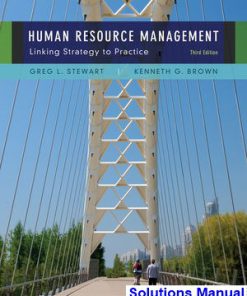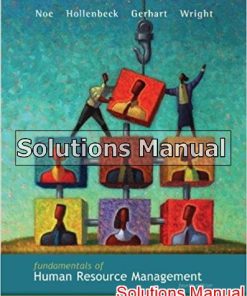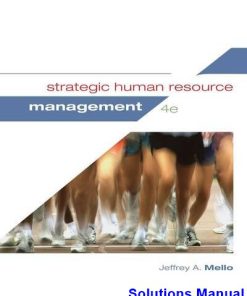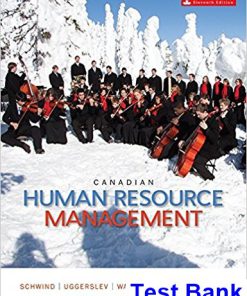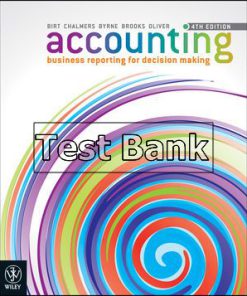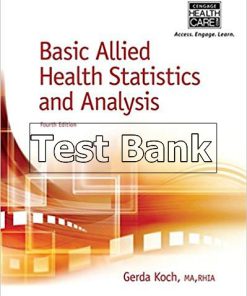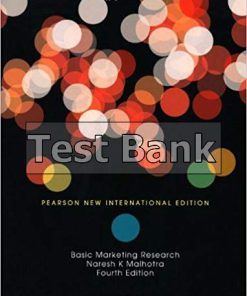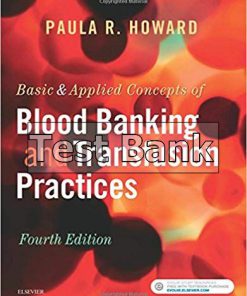Human Resource Management Canadian 4th Edition Steen Solutions Manual
$26.50$50.00 (-47%)
Human Resource Management Canadian 4th Edition Steen Solutions Manual.
You may also like
This is completed downloadable of Human Resource Management Canadian 4th Edition Steen Solutions Manual

Product Details:
- ISBN-10 : 1259087565
- ISBN-13 : 978-1259087561
- Author:
Steen/Noe Fourth Canadian Edition makes HR more accessible to students, more reflective of their situation, and more about them. Today, every manager is “in HR”, and every employee is actively engaged in the process of HRM, regardless of whether they aspire to be a manager or an HR professional. Students will experience HRM every day of their working lives, from how they are perceived by recruiters to completing a performance appraisal, to being promoted or fired. When students ask “What’s In It For Me?”, the Fourth Canadian Edition will show them just how relevant HRM is to them as people, employees and eventually managers.
This easy to read and relevant 11 chapter human resource management text is ideal for a one-semester course. Steen/Noe balances theory with practical application and rich examples that support the need for foundational HRM, thought leadership and applied insight necessary to perform and thrive in organizations today. The Fourth Canadian Edition is suitable for colleges, universities, as well as, professional designation courses, MBA and EMBA programs.
Table of Content:
- Chapter 1: What Is Human Resource Management?
- 1.1: Human Resource Management Day to Day
- 1.2: What Are Human Resources and Human Capital?
- What Is HRM?
- The Role of HRM
- Staffing
- Development of Workplace Policies
- Compensation and Benefits Administration
- Retention
- Training and Development
- Dealing with Laws Affecting Employment
- Worker Protection
- Communication
- Awareness of External Factors
- 1.3: Skills Needed for HRM
- 1.4: Current HRM Challenges
- Containing Costs
- Technology
- The Economy
- The Changing Workforce
- Diversity and Inclusion€
- Ethics and Sustainability€
- 1.5: Cases and Problems
- Endnotes
- Chapter 2: Developing and Implementing Strategic Human Resource Management Plans
- 2.1: The Value of Planning
- 2.2: Strategic Planning
- HRM vs. Personnel Management
- The Steps to Strategic Plan Creation
- Conduct a Strategic Analysis
- Identify Strategic HR Issues
- Prioritize Issues and Actions
- Draw Up an HRM Plan
- 2.3: Writing the HRM Plan
- Determine Human Resource Needs
- Recruit
- Selection
- Determine Compensation
- Develop Training
- Perform a Performance Appraisal
- 2.4: Tips in HRM Planning
- Link HRM Strategic Plan to Company Plan
- Monitor the Plan Constantly
- Understand that Every Industry has Different Needs
- Measure It
- Sometimes Change Is Necessary
- Information Technology
- Be Aware of Legislative Changes
- 2.5: Cases and Problems
- Endnotes
- Chapter 3: Diversity and Inclusion
- 3.1: Culture Fit or Culture Add?€€
- 3.2: Diversity, Inclusion, and Engagement
- Why Diversity and Inclusion?
- 3.3: Diversity and Inclusion (D&I) Planning
- Actions to Take Now
- 3.4: Diversity and the Law
- Equal Employment Opportunity Commission (EEOC)
- EEOC Federal Legislation
- Age
- Disability
- Equal Pay/Compensation
- Genetic Information
- National Origin
- Pregnancy
- Race/Color
- Religion
- Sexual Orientation, Gender Identity, and Sexual Harassment
- Retaliation
- Military Service
- 3.5: Cases and Problems
- Endnotes
- Chapter 4: Recruitment
- 4.1: Keeping Up with Growth
- 4.2: The Recruitment Process
- Recruitment Strategy
- Technology in Recruitment€
- Job Analysis and Job Descriptions
- 4.3: The Law and Recruitment
- Immigration Reform and Control Act
- Patriot Act
- EEO Set of Laws
- 4.4: Recruitment Strategies
- Recruiters
- Campus Recruiting
- Professional Associations
- Websites
- Social Media
- Events
- Special/Specific Interest Groups (SIGs)
- Referrals
- Costs of Recruitment
- 4.5: Cases and Problems
- Endnotes
- Chapter 5: Selection
- 5.1: The Interview
- 5.2: The Selection Process
- 5.3: Criteria Development and Résumé Review
- Criteria Development Considerations
- Validity and Reliability
- Fit vs. Add€€
- Reviewing Résumés
- 5.4: Interviewing
- Types of Interviews
- Interview Questions
- Interview Process
- 5.5: Testing and Selecting
- Testing
- Selection Methods
- 5.6: Making the Offer
- 5.7: Cases and Problems
- Endnotes
- Chapter 6: Compensation and Benefits
- 6.1: Matching Compensation with Core Values
- 6.2: Goals of a Compensation Plan
- 6.3: Developing a Compensation Package
- Internal and External Pay Factors
- 6.4: Types of Pay Systems
- Job Evaluation Systems
- Pay Systems
- Technology Used in Compensation and Benefits
- Pay Theories
- Pay Decision Considerations
- Types of Pay
- Laws Relating to Pay
- 6.5: Other Types of Compensation
- Mandated: Health Care
- Mandated: Social Security and Medicare
- Mandated: Unemployment Insurance and Workers’ Compensation
- Mandated: COBRA
- Voluntary: Incentive Pay Systems
- Voluntary: Medical Insurance (Optional Depending on Company Size)
- Voluntary: 401(k) Plans
- Voluntary: Remote Work Options
- Voluntary: Paid Time Off
- Paid Holidays
- Sick Leave
- Paid Vacation
- Paid Time Off (PTO)
- A Final Note on Compensation and Benefits Strategy
- 6.6: Cases and Problems
- Endnotes
- Chapter 7: Retention, Motivation, and Engagement
- 7.1: Dissatisfaction Isn’t Always about Pay
- 7.2: The Costs of Turnover
- Reasons for Voluntary Turnover
- 7.3: Retention Plans
- Theories on Job Dissatisfaction
- Progression of Job Withdrawal
- Hawthorne Studies
- Maslow’s Hierarchy of Needs
- Herzberg Two-Factor Theory
- McGregor
- Carrot and Stick
- Sources of Employee Satisfaction and Engagement Data
- 7.4: Implementing Retention and Engagement Strategies
- Salaries and Benefits
- Training and Development
- Performance Appraisals
- Succession Planning
- Flextime, Remote Work, and Sabbaticals
- Management Training
- Conflict Management and Fairness
- Job Design, Job Enlargement, Empowerment, and Workflow Design€
- Pay-for-Performance Strategies
- Work-Life Balance
- Other Retention Strategies
- Technology’s Role in Retention and Motivation
- 7.5: Cases and Problems
- Endnotes
- Chapter 8: Training and Development
- 8.1: Training: Not Like It Used to Be
- 8.2: Steps to Take in Training an Employee
- Employee Orientation
- In-House Training
- Mentoring
- External Training
- 8.3: Types of Training
- Technical or Technology Training
- Quality Training
- Skills Training
- Soft Skills Training
- Professional Training and Legal Training
- Team Training
- D&I Training€
- Managerial Training
- Safety Training
- 8.4: Training Delivery Methods
- On-the-Job Coaching Training Delivery
- Mentoring Training Delivery
- Lunch and Learn Training Delivery
- Web-Based Training Delivery
- Job Shadowing Training Delivery
- Job Swapping Training Delivery
- Vestibule Training Delivery
- International Assignment Training
- 8.5: Designing a Training Program
- Training Program Framework Development
- Needs Assessment
- Learning Objectives
- Learning Styles
- Delivery Mode
- Budget
- Delivery Style
- Audience
- Content Development
- Timelines
- Communication
- Measuring Effectiveness
- Career Development Programs and Succession Planning
- Technology Used in Training
- 8.6: Cases and Problems
- Endnotes
- Chapter 9: Successful Employee Communication
- 9.1: The Biggest Challenge
- 9.2: Communication Strategies
- Communication and Emotional Intelligence (EQ)
- Communication Directions
- Communication Styles
- Crisis Communication
- Nonverbal Communication
- Listening
- Diversity and Inclusion (D&I) and Communication€
- Communication and High Performance Work Teams
- 9.3: Management Styles
- Task Style versus People-Centered Style
- Participatory, Directing, or Teamwork Styles
- Autocratic, Participative, and Free-Reign Styles
- Path Goal Model for Leadership
- Applying Management Styles
- 9.4: Cases and Problems
- Endnotes
- Chapter 10: Employee Performance Management
- 10.1: A Call for Help?€
- 10.2: Handling Performance
- Types of Performance Issues
- What Influences Performance?
- Defining Discipline
- The Role of the Performance Appraisal in Discipline
- Performance Issue Model
- Investigation of Performance Issues
- Options for Handling Performance Issues
- Alternative Dispute Resolution
- Employee Separation
- Rightsizing and Layoffs
- 10.3: Employee Rights
- Job Protection Rights
- Privacy Rights
- Labor Unions
- 10.4: Cases and Problems
- Endnotes
- Chapter 11: Employee Assessment and Talent Management
- 11.1: A Tough Conversation
- 11.2: Performance Evaluation Systems
- Designing a Performance Appraisal System
- Performance Evaluation and Technology
- Performance Appraisal System Errors
- Performance Appraisal Legal Considerations
- 11.3: Appraisal Methods
- Graphic Rating Scale
- Essay Appraisal
- Checklist Scale
- Critical Incident Appraisals
- Work Standards Approach
- Ranking Methods
- Management by Objectives (MBO)
- Behaviorally Anchored Rating Scale (BARS)
- 11.4: Completing and Conducting the Appraisal
- Best Practices in Performance Appraisals
- Training Managers and Employees
- Organizing the Performance Appraisal Process
- Performance Appraisal Interviews
- 11.5: Cases and Problems
- Endnotes
- Chapter 12: Working with Labor Unions
- 12.1: Unhappy Employees Could Equal Unionization
- 12.2: The Nature of Unions
- History and Organization of Unions
- Current Union Challenges
- Labor Union Laws
- The Unionization Process
- Strategies Companies Use to Avoid Unionization
- The Impact of Unions on Organizations
- 12.3: Collective Bargaining
- The Process of Collective Bargaining
- Ramifications of a Bargaining Impasse
- Working with Labor Unions
- 12.4: Administration of the Collective Bargaining Agreement
- Procedures for Grievances
- 12.5: Cases and Problems
- Endnotes
- Chapter 13: Safety and Health at Work
- 13.1: Training for Safety
- 13.2: Workplace Safety and Health Laws
- Occupational Safety and Health Administration (OSHA) Laws
- Right-to-Know Laws
- OSHA Enforcement
- 13.3: Health Hazards at Work
- Stress
- Cumulative Trauma Disorders
- Video Display Terminals (VDTs)
- Chemical and Fragrance Sensitivities
- Chemicals and Substances
- Workplace Violence and Bullying
- Employee Privacy
- Terrorism and Evacuation€
- Promoting a Culture of Safety and Health
- 13.4: Cases and Problems
- Endnotes
- Chapter 14: International Human Resource Management
- 14.1: Things Weren’t What They Seemed
- 14.2: Offshoring and Outsourcing
- The Global Environment
- HRM Global Strategies
- Culture as a Major Aspect of HRM Overseas
- 14.3: Staffing Internationally
- Types of Staffing Strategy
- Expatriates
- Host-Country National
- Third-Country Nationals
- 14.4: International HRM Considerations
- Recruitment and Selection
- Training
- Compensation and Rewards
- Performance Evaluations
- The International Labor Environment
- Logistics of International Assignments
- 14.5: Cases and Problems
- Endnotes
- Appendix A: The Purpose of Society for Human Resource Management (SHRM) and Human Resources Certific
- A.1: Society for Human Resource Management (SHRM)
- A.2: Human Resources Certification Institute (HRCI)
- Index
People Also Search:
human resource management canadian steen
human resource management canadian 4th edition steen
human resource management canadian
human resource management canadian 4th edition solution manual download pdf
human resource management canadian 4th edition download scribd
canadian human resource management textbook
human resource management canadian 4th edition
steen human resource management canadian

